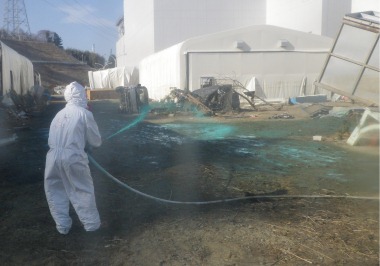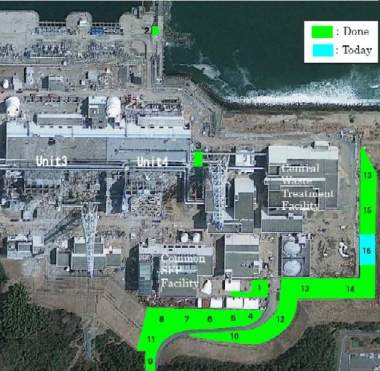ORIGINALLY PUBLISHED: 12.40pm GMT
UPDATE 1: 2.23pm GMT, Map of spray areas and robot data
Full-scale spraying of agents to control dust scattering is taking place at Fukushima Daiichi. The work should limit travel of radioactive material beyond the site boundary.
In the long accident sequence at the power plant since the tsunami of 11 March there has been venting of radioactive steam and the apparent rupture of unit 2's torus as well as various fires near used fuel ponds and hydrogen explosions. All of these have served to distribute radionuclides, much of which landed in the immediate area of the site on muddy ground left by the tsunami.
 |
 |
| Left: A Tepco worker tests the anti scattering agent in a debris-strewn area near the shared used fuel pond; Right: Areas being sprayed | |
Since the end of March Tokyo Electric Power Company has undertaken several trials of a chemical agent meant to bind dust on site into larger particles that are less likely to be carried by the wind. Now these trials have been expanded to a far larger area around the southern and western edges of main plant buildings.
Tepco said this 'trial' will continue until 26 April and that it will conduct full-scale use from 26 April to the end of May.
Robots return data Remote controlled robots exploring conditions inside the reactor buildings of units 1, 2 and 3 have sent back the following data. Unit 1 Radiation: 10-49 millisiverts per hour Unit 2 Radiation: 4.1 millisiverts per hour Unit 3 Radiation: 28-57 millisiverts per hour Oxygen is at around the normal atmospheric density of 20% in all three units. |
Researched and written
by World Nuclear News




_28178.jpg)
_66891.jpg)
_55296.jpg)
_16128_62584.jpg)





